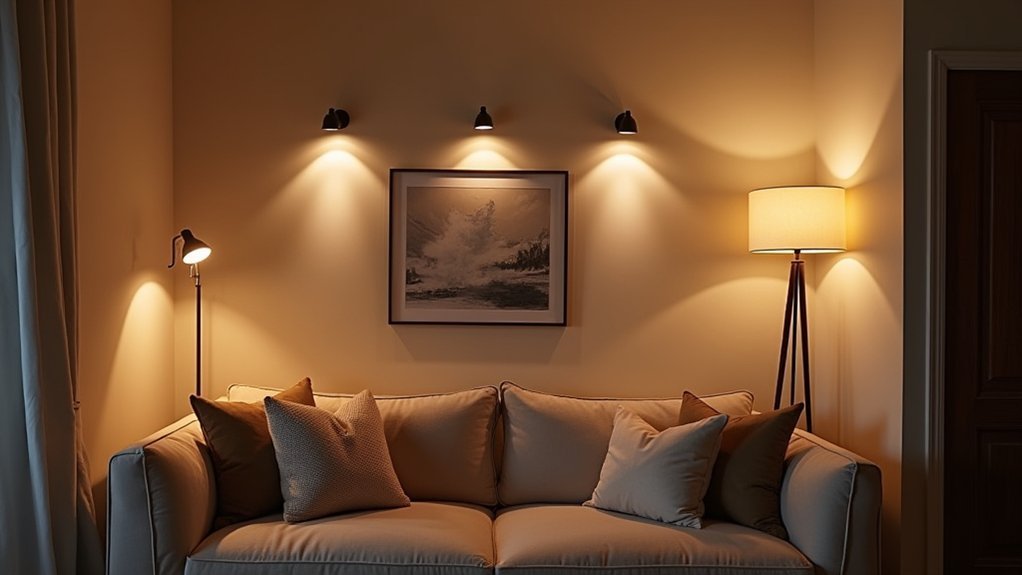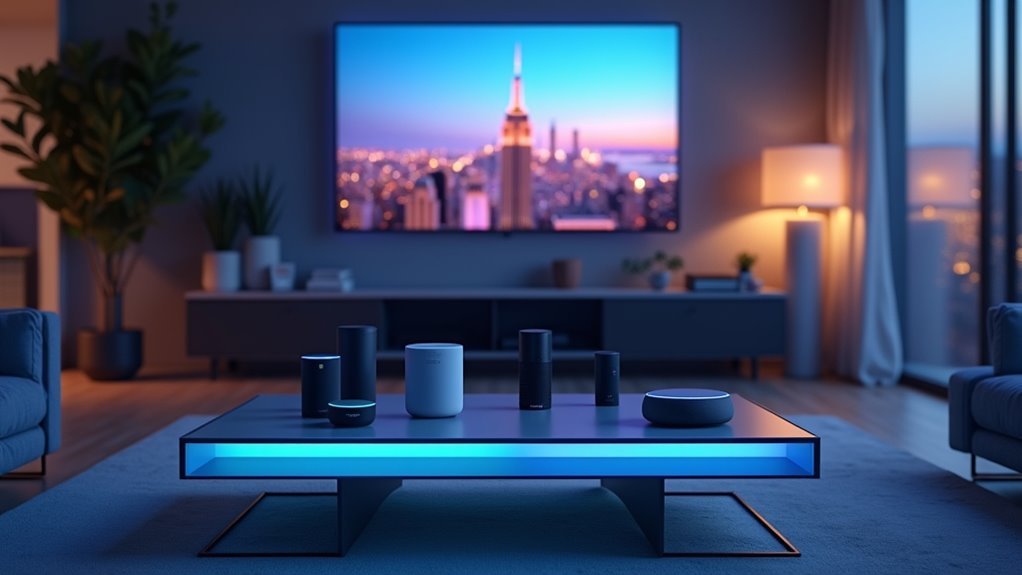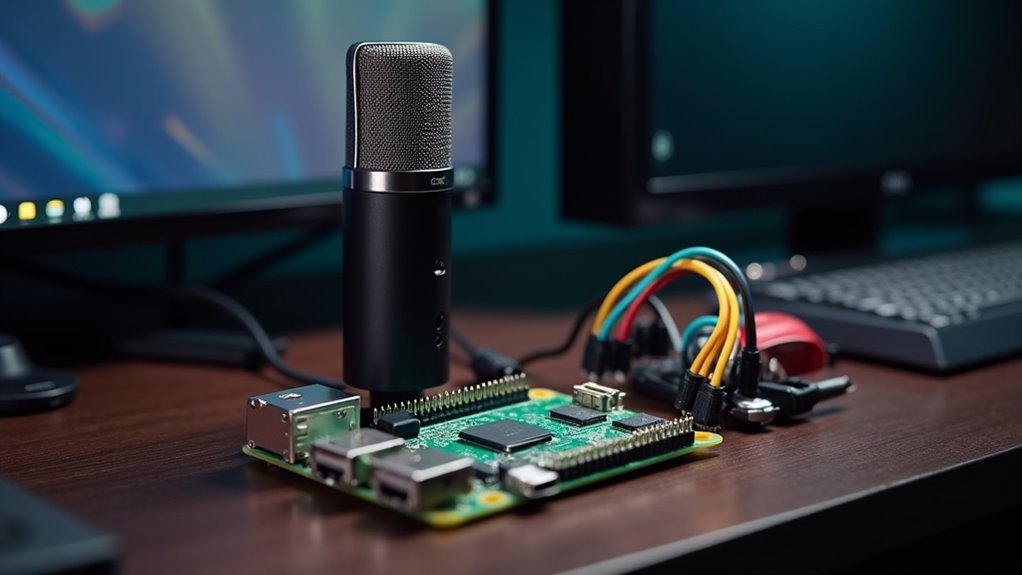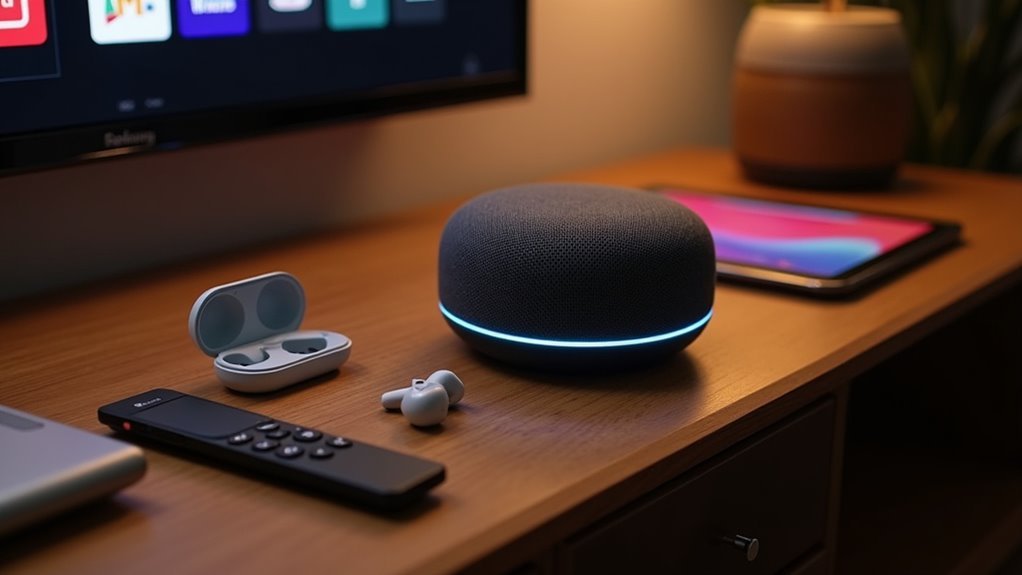Transform your home with these smart lighting hacks: strategically place bulbs in corners and under cabinets for ideal coverage, choose no-hub options to save money and simplify setup, create voice command shortcuts for effortless control, set up automated lighting scenes without programming skills, and implement energy-saving schedules with sensors. These techniques will slash your energy bills while creating the perfect ambiance for every occasion. Discover how these simple tweaks can revolutionize your living space.
Strategic Bulb Placement for Maximum Coverage and Effect

When setting up a wireless smart lighting system, strategic bulb placement is the foundation for creating both functional and aesthetically pleasing environments. Consider installing smart bulbs in high ceilings to distribute light evenly and reduce shadows throughout your space.
For task-specific areas, position lights under kitchen cabinets to illuminate countertops while cooking, or install light strips under shelves and desks to reduce eye strain.
Don’t forget the corners of rooms—placing bulbs there minimizes glare while improving coverage.
Create depth through layered lighting by combining overhead fixtures with table and floor lamps. To enhance productivity, implement tunable white bulbs that can adjust from warm to cool light based on your activities throughout the day. For enhanced ambiance, position lights behind furniture to add warmth and coziness.
In high-traffic pathways, motion-activated lights offer both convenience and safety while maximizing your smart lighting system’s potential.
No-Hub Solutions: Simplifying Your Smart Lighting Network
Three compelling advantages make no-hub smart lighting solutions increasingly popular for homeowners seeking simplicity.
You’ll enjoy significant cost savings without purchasing additional hubs, plus benefit from a streamlined setup process that connects bulbs directly to your Wi-Fi or Bluetooth. Installation becomes a breeze when your smartphone controls lights directly.
While no-hub systems offer fewer advanced features than hub-based alternatives, they still deliver impressive functionality. You can adjust brightness, change colors, and create custom light scenes through dedicated apps. Many integrate with voice assistants like Alexa or Google Assistant for hands-free control. Wireless control contributes to both convenience and efficiency in these simplified systems.
The energy-efficient LED technology in these bulbs, combined with scheduling capabilities, helps reduce your electricity consumption.
For beginners or those wanting a straightforward smart lighting experience, no-hub solutions provide an ideal entry point.
Voice Command Shortcuts for Effortless Control

Voice commands take your no-hub smart lighting to the next level, transforming how you interact with your home. Create intuitive shortcuts like “movie time” that dim lights, adjust colors, and even control other devices with a single phrase.
Set up these shortcuts by linking your smart bulbs to Alexa, Google Assistant, or HomeKit. Choose concise, natural phrases such as “kitchen lights on” rather than lengthy technical names. For maximum effectiveness, focus on controlling single rooms rather than individual fixtures to create a more intuitive experience.
Group lights by zones with memorable names like “reading corner” or “dinner mode” for faster recognition. For maximum effectiveness, design multi-action shortcuts that combine lighting changes with other smart home functions.
Test your commands regularly and refine them based on your usage patterns, ensuring your voice-controlled lighting remains responsive and perfectly tailored to your lifestyle.
Creating Automated Lighting Scenes Without Programming Skills
Although automation might sound technical, creating stunning lighting scenes in your wireless setup requires zero programming knowledge. Most smart lighting apps offer pre-built scene templates you can easily customize using intuitive interfaces with sliders and color wheels. Smart lighting scenes significantly enhance home design and can be tailored to complement your lifestyle needs.
| Scene Type | Best For | Activation Method |
|---|---|---|
| Relaxation | Evening unwinding | App or voice command |
| Reading | Focused tasks | Physical keypad |
| Entertainment | Social gatherings | Motion sensor |
| Night mode | Safe navigation | Time schedule |
Beyond the app, physical controllers like wall-mounted keypads and wireless remotes give you tactile control options. For true automation, combine timers with sensors – set lights to activate when you enter rooms or adjust based on natural light levels. These scene automations work seamlessly across multiple rooms without writing a single line of code.
Energy-Saving Tricks Through Smart Scheduling and Sensors

While creating beautiful automated scenes enhances your home’s ambiance, smart lighting’s most compelling advantage lies in its energy-saving potential.
LED bulbs alone use 75% less energy than incandescent options, but when paired with smart scheduling, you’ll see savings of 35-70% on lighting costs.
Set up time-based adjustments that automatically dim lights during daylight hours and turn them off when you’re away.
Integrate motion and ambient light sensors to guarantee lights activate only when needed and adjust brightness based on natural light availability. This sensor-based approach eliminates wasteful lighting without sacrificing convenience.
For maximum efficiency, use your system’s monitoring features to track consumption patterns and make real-time adjustments. Remote monitoring systems provide real-time energy consumption data that helps you optimize your lighting strategy.
With minimal effort, you’ll reduce both your carbon footprint and utility bills while enjoying the convenience of automated lighting.
Frequently Asked Questions
Can Smart Bulbs Work With Existing Dimmer Switches?
No, you shouldn’t use smart bulbs with existing dimmer switches. They’re incompatible and can cause flickering, inconsistent brightness, or damage to your bulbs. Instead, use smart bulbs with regular switches kept in the “on” position.
How Do I Troubleshoot Connectivity Issues With Smart Lights?
To troubleshoot connectivity issues with your smart lights, first power cycle both bulbs and router. Confirm you’re using a 2.4 GHz network, update firmware regularly, and verify the bulb is in pairing mode during setup attempts.
Will Smart Bulbs Affect My Home’s Wi-Fi Performance?
Smart bulbs use minimal bandwidth but can impact Wi-Fi if you have many devices. They’re unlikely to slow your network noticeably unless you’re already near your bandwidth limits or using an outdated router.
Can I Control Smart Lighting During Internet Outages?
Yes, you can control smart lighting during internet outages if you use systems with local control capability. Zigbee-based setups (like Philips Hue with Bridge) or Bluetooth-enabled bulbs will work without internet access for basic functions.
How Do I Integrate Outdoor Lighting Into My Smart Home System?
Connect weather-resistant smart lights to your home network, place them in key areas like pathways and entryways, and guarantee Wi-Fi coverage reaches outdoors. Use your smart home app to create schedules and automation routines.
In Summary
You’ve now mastered the essentials of wireless smart lighting. By placing bulbs strategically, choosing hub-free options, setting up voice commands, creating automated scenes, and implementing energy-saving schedules, you’ll transform your home into a responsive, efficient space. These simple hacks don’t require technical expertise but deliver impressive results. Enjoy your new smart lighting system—it’s not just convenient, it’s a game-changer for your daily life.





Leave a Reply